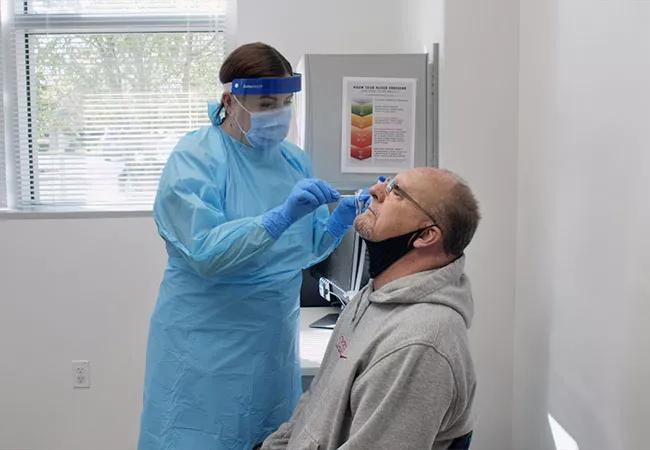Nomogram reveals new characteristics that may affect risk

Cleveland Clinic researchers have developed the world’s first risk prediction model for healthcare providers to forecast an individual patient’s likelihood of testing positive for COVID-19 as well as their outcomes from the disease.
Cleveland Clinic is a non-profit academic medical center. Advertising on our site helps support our mission. We do not endorse non-Cleveland Clinic products or services. Policy
According to a new study published in CHEST, the risk prediction model shows the relevance of age, race, gender, socioeconomic status, vaccination history and current medications in COVID-19 risk. The risk calculator is a new tool to aid healthcare providers in predicting patient risk and tailoring decision-making about care. It is intended to help providers prioritize COVID-19 testing but is not designed for use by asymptomatic individuals who are merely curious about their risk.
“The ability to accurately predict whether or not a patient is likely to test positive for COVID-19, as well as potential outcomes including disease severity and hospitalization, will be paramount in effectively managing our resources and triaging care,” says Lara Jehi, MD, Cleveland Clinic’s Chief Research Information Officer and lead author on the study. “As we continue to battle this pandemic and prepare for a potential second wave, understanding a person’s risk is the first step in potential care and treatment planning.”
The nomogram, which has been deployed as a freely available online risk calculator, was developed using data from nearly 12,000 patients enrolled in Cleveland Clinic’s COVID-19 registry, which includes all individuals tested at Cleveland Clinic for the disease, not just those who test positive.
Data scientists, led by study senior author Michael Kattan, PhD, Chair of Quantitative Health Sciences in Cleveland Clinic Lerner Research Institute, used statistical algorithms to transform data from registry patients’ electronic medical records into the first-of-its-kind nomogram.
The study revealed several novel insights into disease risk, including:
“Our findings corroborated several risk factors for a positive test already reported in the literature — including male sex and advanced age — but we also put forth some new associations,” says Dr. Jehi. “Further validation and research are needed into these initial insights, but these correlations are extremely intriguing.”
In a previous network medicine study led by Lerner Research Institute scientists, 16 drugs (including melatonin, carvedilol and paroxetine) and three drug combinations were identified as candidates for repurposing as potential COVID-19 treatments. While these findings suggest an association between taking these medications and reduced risk of testing positive for COVID-19, additional studies are needed to assess how these drugs may affect disease progression.
“The data suggest some interesting correlations but do not confer cause and effect,” notes Dr. Kattan. “For example, our data do not prove that melatonin reduces your risk of testing positive for COVID-19. There may be something else about patients who take melatonin that is indeed responsible for their apparent reduced risk, and we don’t know what that is. Consumers should not change anything about their behavior based on our findings.”
The nomogram, developed using data from patients tested at Cleveland Clinic for COVID-19 before April 2, 2020, showed good performance and reliability when used in a different geographic region (Florida) and over time (for patients tested after April 2, 2020). This suggests that the patterns and predictors identified in the model are consistent across regions and communities and can be potentially adopted for clinical practice in healthcare systems across the country.
“This nomogram will bring precision medicine to the COVID-19 pandemic, helping to enable researchers and physicians to predict an individual’s risk of testing positive,” says Dr. Kattan. “Additionally, while testing solutions continue to be needed, it is important to make sure we are responsibly and optimally dispatching our resources — including clinical personnel, personal protective equipment and hospital beds. Our risk prediction model stands to greatly assist hospital systems in this planning.”
Dr. Jehi adds that it’s key that the nomogram’s intended purpose remain clear. “We want to emphasize that this freely accessible nomogram is designed for use by, or in consultation with, healthcare professionals for prioritizing testing,” she notes. “The calculator is not intended for use by individuals who are ‘curious’ about their risk but do not have symptoms suggestive of COVID-19. It is important to caution against consumers interpreting a low risk score as license to ease up on infection prevention measures such as social distancing and masking, as those decisions have public health implications beyond individual risk.”
The COVID-19 research registry, which now has data from more than 23,000 patients, is being used to inform a variety of studies. Researchers from across Cleveland Clinic health system are using the dynamic registry data in more than 140 research projects related to COVID-19 in areas such as cancer, pediatrics and intensive care.

Patients report improved sense of smell and taste

Clinicians who are accustomed to uncertainty can do well by patients

Unique skin changes can occur after infection or vaccine

Cleveland Clinic analysis suggests that obtaining care for the virus might reveal a previously undiagnosed condition

As the pandemic evolves, rheumatologists must continue to be mindful of most vulnerable patients

Early results suggest positive outcomes from COVID-19 PrEP treatment

Could the virus have caused the condition or triggered previously undiagnosed disease?

Five categories of cutaneous abnormalities are associated with COVID-19